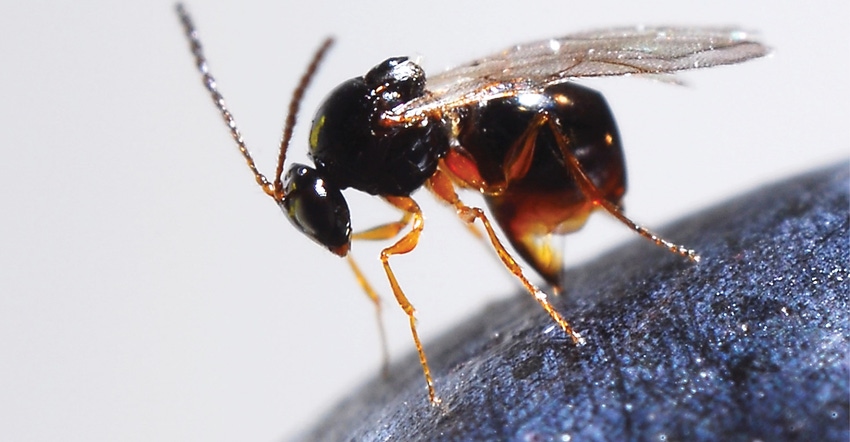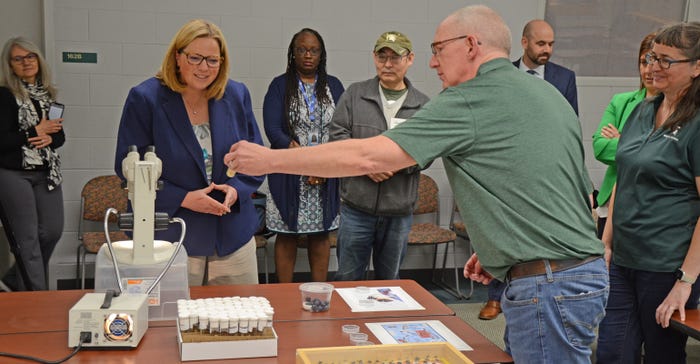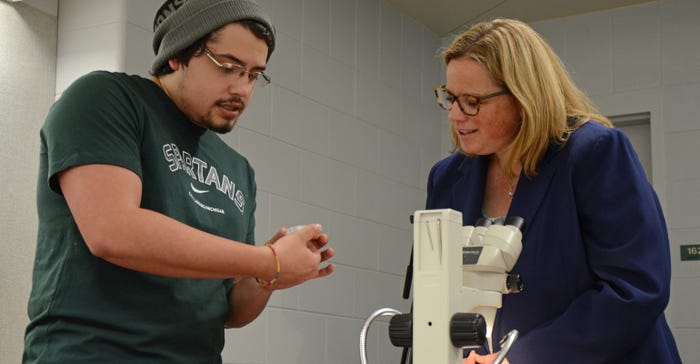
To save their crops from massive destruction, fruit farmers are having to spray pesticides — often multiple times — to combat the invasive vinegar fly, spotted wing drosophila.
It costs growers millions of dollars to preserve quality and yield of their crops. But now, for the first year, scientists and researchers are introducing a new weapon in this fight — tiny SWD-killing parasitoid samba wasps, also known by the name Ganaspis brasiliensis.
The wasp kills SWD by laying eggs inside the insect. When the wasp hatches, its larva consumes its prey. Spotted wing drosophila populations should then be reduced when the wasps are there to contribute to the fly-fighting cause, according to preliminary data.
The wasps are being released this summer in fruit orchards, berry fields and other SWD-susceptible crops in prime growing regions throughout the U.S.
An adult SWD lays her eggs — up to 300 per female — within ripening fruit. When the larvae emerge, they burrow in and start eating the fruit from the inside out, causing damage that can result in severe crop losses, said Rufus Isaacs, one of the researchers working with this insect and collaborating with Julianna Wilson to release wasps in blueberry and cherry farms in Michigan.
Isaacs recently made the announcement of the wasp’s release when USDA Undersecretary Jennifer Lester Moffitt visited Michigan State University to announce a series of 14 USDA-Agricultural Marketing Service grants.
Biocontrol agent
Although researchers don’t expect immediate results, the availability of this new biocontrol agent opens up a new chapter in research on this devastating pest. “If growers could control this better on the farm, they could be using fewer pesticides, and we could get back to what I would consider normal IPM before this invasive species arrived,” Isaacs said.
SWD is difficult to control because of its high reproductive rate and strong dispersal abilities, and, unlike most fruit flies, female SWD can pierce the skin of undamaged soft-skinned fruits such as cherries and berries to lay eggs.
“We're excited about the wasp because it's a new direction and tool we haven't had in our toolbox for controlling SWD until now,” Isaacs said.

CONTROLLING SWD: Rufus Isaacs, one of the MSU researchers working on the wasp release, recently made the announcement of the release when USDA Undersecretary Jennifer Lester Moffitt visited MSU to announce a series of 14 grants — one helping to fund this project. Here, Isaacs explains to Moffitt how the wasps will help control SWD.
A native to southeast Asia, SWD was detected in Hawaii in the 1980s and in the continental U.S. in California in 2008. It is now widespread through many parts of the U.S. and the world.
One of the MSU researchers, Juan Huang, recently traveled to the USDA lab in Delaware and received training on the rearing process. She returned with 100 of these insects, and MSU has been mass-rearing since.
Now that sufficient numbers of wasps are in their colony, releases will begin around the state in major fruit-growing regions along Lake Michigan from Van Buren to Leelenau counties. The researchers will assess the impact of this new species on SWD populations and its potential for establishment in Michigan’s climate.
Researchers hope to build the wasp numbers up naturally, so they don’t have to keep doing releases. “We'll learn a lot in the next couple of years about how much potential there is for controlling SWD,” Isaacs added.
Due diligence in release
Damage from the invasive insect costs the country’s agricultural industry about $500 million per year, according to a new review in the Journal of Economic Entomology. SWD particularly likes dark, soft fruit, delivering a $100 million loss to the blueberry industry.
Twelve years of research leading up to this year’s wasp release included an extensive evaluation of all kinds of different wasp species. “This was one of the most promising,” Isaacs said. “It was tested against a lot of different fly species, and this one was purposely selected for SWD. It's selective on SWD in fruit without impacts on many other species of vinegar flies.”
Before USDA granted its approval of the wasp release, it was approved by the biocontrol committee of the North American Plant Protection Organization for release in the U.S., Canada and Mexico.
“It requires a lot of data and testing out all the potential negative side effects it could have,” Isaacs said. “We would not have had the approval for rearing and releasing it without having passed the review by multiple experts independent of people working in this project.”

UP CLOSE: Andrew Jones, research technician in the Department of Entomology at Michigan State University, gives USDA Undersecretary Jennifer Lester Moffitt an up-close view of a samba wasp.
Several concerns were addressed during the process, as new requests went back and forth in revision. “It's never zero risk, but I think the risk for this is very low,” Isaacs said. “And the other insects that it might affect are things like common vinegar flies that we get in our kitchens, which people don't want anyway.”
SWD continues to be the No. 1 priority for the Michigan cherry, blueberry and raspberry industries. Penn State University Extension reports that in the Northeast, SWD has had the most impact on raspberries and blackberries, especially fall-harvested cultivars. And, on occasion, some day-neutral strawberries harvested in the fall have been severely affected.
Other major fruit-growing states will be collaborating in this national project. “We’ll be comparing methods to make sure we’re all doing things right and then comparing results from each state,” Isaacs said. “People should understand this is not going to be a magic bullet that immediately changes things. However, it is an interesting new tool, and we'll try and evaluate it as best we can to see how it fits into the program.”
About the Author(s)
You May Also Like






